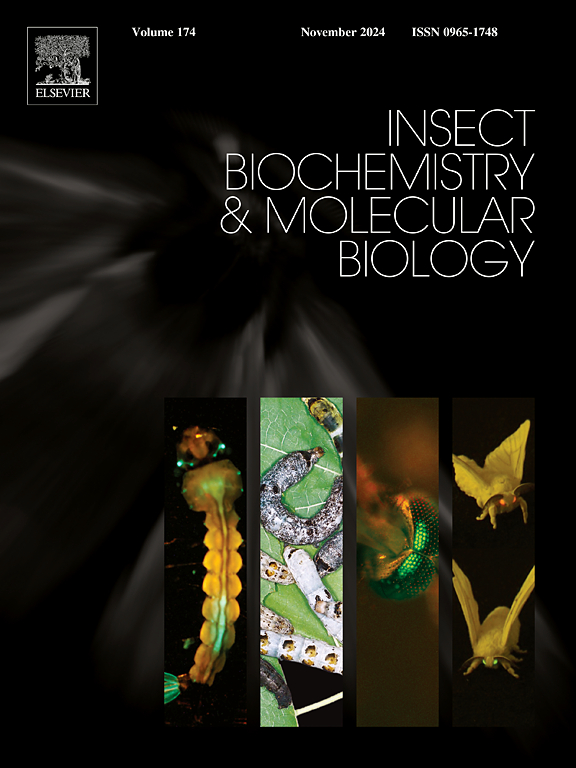白蚁嗅觉蛋白与寄主挥发物、游离脂肪酸和角质层碳氢化合物的结合特性。
IF 3.2
2区 农林科学
Q2 BIOCHEMISTRY & MOLECULAR BIOLOGY
引用次数: 0
摘要
白蚁是盛行于热带和亚热带地区的社会性昆虫,具有高度组织化的行为和超强的适应能力,其根源在于种姓分化和化学交流。这些特征使它们成为研究昆虫社会结构和生态相互作用的极佳模型。研究白蚁如何利用化学信号来感知和应对环境,可以深入了解它们在复杂生态系统中的协调和适应能力。本研究深入研究了白蚁的化学感应机制,考察了四种嗅觉蛋白与 70 种配体的相互作用,包括宿主挥发物、角质烃(CHC)和游离脂肪酸(FFA)。分子对接模拟揭示了嗅觉蛋白对长链碳氢化合物(n-C23 至 n-C28)的不同亲和力,这表明通过特异性碳氢化合物检测形成了一个微妙的化学通讯系统。RacuCSP1 和 RacuCSP2 分别表现出与亚油酸和十一烷酸的特异性结合,突显了脂肪酸在白蚁生理和行为过程中的重要性。在荧光竞争结合实验中,四种嗅觉蛋白对长芴具有很强的亲和力。值得注意的是,RacuOBPs对β-珑和新伞花烯等萜类挥发物表现出独特的亲和力,而RacuCSPs则与3-蒈烯、桃烯醇、α-氧化蒎烯和β-蒎烯等萜类化合物特异性结合,这表明它们在宿主检测中起着关键作用。基因沉默后的行为观察显示,RacuOBP5 是识别长叶烯和α-珑的关键,而 RacuCSP1 则是白蚁检测α-蒎烯的关键。这些发现加深了我们对白蚁化感系统的了解,为制定精确的害虫管理策略提供了启示。本文章由计算机程序翻译,如有差异,请以英文原文为准。

Binding properties of olfactory proteins to host volatiles, free fatty acids and cuticular hydrocarbons in the termite Reticulitermes aculabialis
As eusocial insects prevalent in tropical and subtropical regions, termites are characterized by highly organized behaviors and exceptional adaptability, rooted in caste differentiation and chemical communication. These traits make them excellent models for studying insect social structures and ecological interactions. Investigating how termites use chemical signals to perceive and respond to their environment provides insights into their coordination and adaptation within complex ecosystems. This study delved into the chemosensory mechanisms of Reticulitermes aculabialis, examining the interactions of four olfactory proteins with 70 ligands, including host volatiles, cuticular hydrocarbons (CHCs), and free fatty acids (FFAs). Molecular docking simulations revealed varied affinities of the olfactory proteins for long-chain hydrocarbons (n-C23 to n-C28), suggesting a nuanced chemical communication system through specific hydrocarbon detection. RacuCSP1 and RacuCSP2 exhibited specific binding to linoleic acid and undecanoic acid, respectively, highlighting the significance of FFAs in the physiological and behavioral processes of termites. The four olfactory proteins showed a strong affinity for longifolene in fluorescence competitive binding experiments. Notably, RacuOBPs exhibited unique affinities for terpenoid volatiles such as β-lonone and neocembrene, while RacuCSPs specifically bound with terpenoids like 3-carene, myrtenol, α-pinene oxide and β-pinene indicating their critical roles in host detection. Behavioral observations following gene silencing revealed that RacuOBP5 was essential for recognizing longifolene and α-lonone recognition, while RacuCSP1 was key for detecting α-pinene in termites. These findings enhance our understanding of the termite chemosensory system and offer insights for developing precise pest management strategies.
求助全文
通过发布文献求助,成功后即可免费获取论文全文。
去求助
来源期刊
CiteScore
7.40
自引率
5.30%
发文量
105
审稿时长
40 days
期刊介绍:
This international journal publishes original contributions and mini-reviews in the fields of insect biochemistry and insect molecular biology. Main areas of interest are neurochemistry, hormone and pheromone biochemistry, enzymes and metabolism, hormone action and gene regulation, gene characterization and structure, pharmacology, immunology and cell and tissue culture. Papers on the biochemistry and molecular biology of other groups of arthropods are published if of general interest to the readership. Technique papers will be considered for publication if they significantly advance the field of insect biochemistry and molecular biology in the opinion of the Editors and Editorial Board.

 求助内容:
求助内容: 应助结果提醒方式:
应助结果提醒方式:


